Construction of the first Romanesque church
First documented mention of the church and parish of St. Stephen in the Treaty of Mautern, an exchange contract between Babenberg Duke Leopold IV of Austria and Bishop Reginmar of Passau. Many sources believe this to be when construction of the first St. Stephen’s Church began.
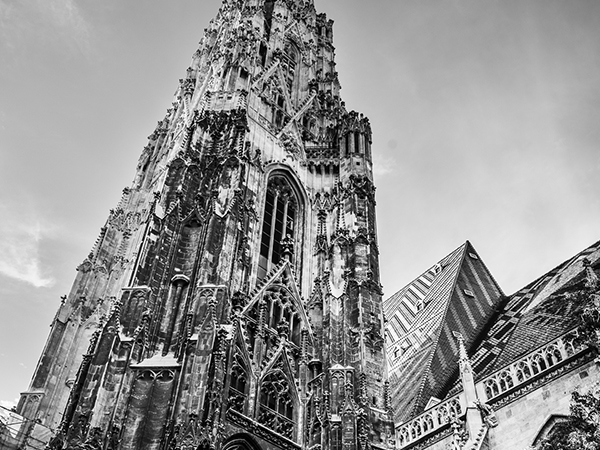
Consecration of the first St. Stephen’s Church
Consecration of the first Romanesque St. Stephen’s Church, though this was likely a partial consecration. Due to its already considerable size, it cannot be assumed that the church had already been completed by this time. It remains uncertain whether parts of this church, consecrated in 1147, are still preserved on the ground floor of the western complex. For the first time, a priest called Eberhard is mentioned by name who comes into mind in connection with the old story about the ‘Eberhardslinde’. Until the early 13th century, no priest was known by name, which suggests a smooth occupation of the parish. This first Romanesque church was still located outside Vienna’s oldest city wall.
Construction of the second Romanesque church
Construction of the second Romanesque church is assumed to have taken place in the early 12th century. The Romanesque parts of the mighty west side are still visible today, among them the substructure of the western ‘Heidentürme’, the ‘Pagan Towers’, and the main portal, known as the ‘Riesentor’ (the ‘Giant’s Door’), of the cathedral church, which were principally constructed during this time.
Great fire
Damage to St. Stephen as a result of a great fire in the city, though the extent of the damage is not known. The reconsecration of St. Stephen’s Church in 1263 following the fire suggest that only minor damage occurred.
Construction of the Gothic choir
In the year 1300, the chronicler at the Zwettl monastery reports of the citizens wanting to expand the choir in their parish church. For this purpose, a house to the east of St. Stephen’s Church had to be purchased as it stood in the way of the new building project. The purchase negotiations were concluded in 1304, the year in which construction of the new Gothic choir is assumed to have begun.
Consecration of the new choir
On 23 April 1340, the first Sunday after Easter, Bishop Albert of Passau consecrated the new Gothic choir. From the coats of arms visible in certain series of glass paintings, it can be concluded that these were ducal donations, though sadly only fragments remain. This is why, despite funding from both the town and citizens, the name ‘Albertine Choir’, after Duke Albert II, also appears. The inspiration for this choir was probably the Cistercian Abbey Church of Heiligenkreuz in the Wienerwald, which had been built some decades earlier.
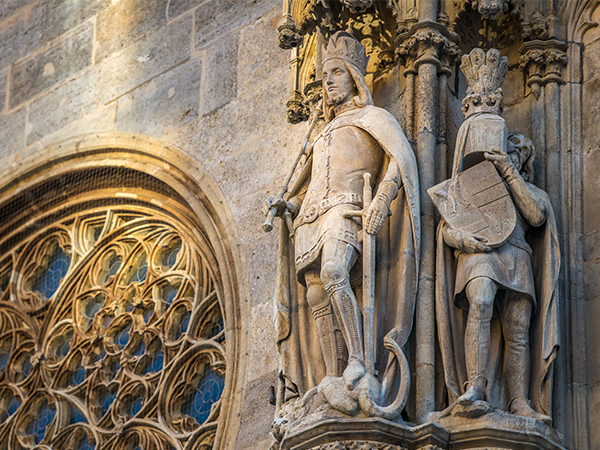
Foundation of the All Saints’ Chapter
This is the year of the foundation of the All Saints’ Chapter (now Cathedral Chapter) by Duke Rudolf IV, the ‘Founder’, as an administrative institution to gain independence from the diocese of Passau. Duke Rudolf was born on All Saints’ Day in 1339 in the castle in Vienna. He first founded the All Saints’ Chapters for the Hofburg Chapel and then transferred them to the west gallery of St. Stephen’s Church. This created the conditions for a future cathedral chapter and independent diocese. The cathedral chapter is responsible for the administration of the cathedral church and made up of twelve priests today.
Completion of the South Tower
The South Tower, whose actual name is ‘Stephansturm’, was completed in 1433 under master builder Hans Prachatitz. This high tower is 136.4 metres high with its crown and was considered the highest church tower in Europe on completion.
Construction of the North Tower begins
The construction of the North Tower, whose actual name is ‘Adlerturm’, followed Rudolf IV’s original two-tower concept and the necessary substructures were created in 1450 under Emperor Frederick III. It was not until 17 years later that the first foundation stone was laid.
Vienna is now diocesan town
It was only Emperor Frederick III who succeeded in obtaining the Papal bull ‘In suprema dignitatis specula’ from Pope Paul II in 1469, granting Vienna its own episcopal see. The new diocese originally comprised only the city area of Vienna and extended to Mödling in the south. Nevertheless, the diocese was considered poor, which is why the first bishop of Vienna, Leo von Spaur, probably never exercised his office and the diocese was managed only by administrators until 1513. The first bishop to actually reside in Vienna was Bishop Slatkonia.
The unfinished North Tower
The construction of the North Tower is discontinued. In addition to the Reformation, the reason for this was the ever greater danger from the closing in Turkish armies, which made the expansion of the city’s fortifications a priority. Thus, the North Tower’s last set of stones bears the year 1511.
Construction of the Renaissance cap
The unfinished North Tower was gloriously completed in 1578 when it received a domed cap. There, you can admire the cathedral church’s big bell, the ‘Pummerin’, weighing over 21 tonnes.
Consecration of the baroque High Altar
The High Altar was created by Johann Jakob Pock and his brother Tobias Pock on behalf of Prince Bishop Phillip Friedrich Graf Breuner. It is an example of early baroque altar architecture, made mainly of black Polish marble and occupying almost the entire height of the Gothic choir. The altarpiece depicts the stoning of St. Stephen. The consecration took place on 19 May 1647. On completion of the altar, Prince Bishop Breuner also donated a magnificent cope to the cathedral church, which is used every year on the feast day of St. Stephen on 26 December. This ‘Breuner Ornat’ (cope) is among the most important early baroque attire.
‘Pummerin’
Austria’s largest bell, the ‘Pummerin’ was cast by Johann Achammer in 1711. It was raised in the South Tower and rung for the first time on 26 January 1712. On 12 April 1945, the bell was destroyed as it fell during the fire in the cathedral. A new bell weighing 21,100 kg was cast in 1951 in St. Florian (Upper Austria) and this new ‘Pummerin’ has hung in the north tower since October 1957.
St. Stephen’s becomes a metropolitan church
Following Prince Eugene’s great victories, a plan was drawn up to give Vienna, the seat of the Austrian monarchy, the dignity it deserved – an archdiocese. The Papal bull ‘Suprema dispositione’ from 1 June 1722 under Pope Innocent XIII finally saw the archdiocese of Vienna established. Thus, the Pope elevated St. Stephen to the status of a metropolitan church and the diocese of Vienna to an archdiocese. The solemn elevation only took place on 24 February 1723. In the city and diocese of Wiener Neustadt, the new archbishop was to exercise the rights of a metropolitan, together with all titles, privileges, and honours.
Catacombs
In 1732, the ‘St. Stephans Freidhoff’, the cemetery of the cathedral church, was closed. Subsequently, the catacombs below the cathedral square were set up as underground burial places.
Closure of inner-city cemeteries
From the 16th century onwards, there were repeated efforts to close the cemeteries that lay within the city walls. There was resistance to this, because of fears that burial sites outside the walls would be devastated in the event of a war. It was only under Joseph II that the inner-city cemeteries were finally abolished as of 1783, which also led to a ban on burials in the catacombs.
Removal of the South Tower’s spire
In 1809, the South Tower had been damaged by French bombardment. The derelict steeple was removed in 1860 by master cathedral builder Leopold Ernst, and rebuilt in stone between 1862-64 under Friedrich von Schmidt. On 18 August 1864, a new cross and eagle with Emperor Franz Joseph’s initials and motto was placed on the spire.
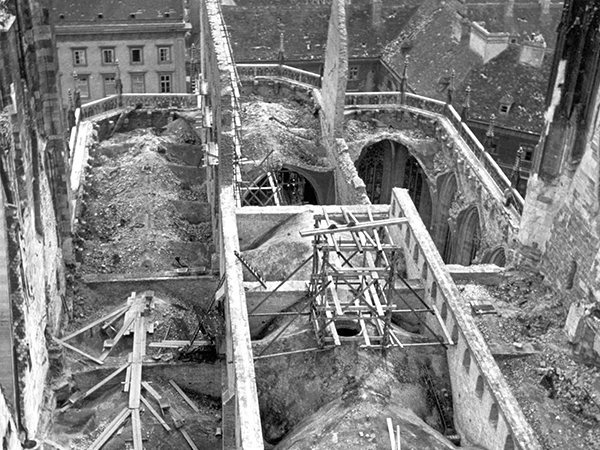
Cathedral fire
In the final days of the Second World War, flying sparks from burning houses in the vicinity caused a fire in the Gothic wooden roof truss. This led to the collapse of a supporting wall of the choir’s roof truss, which penetrated the vaults of the south and middle choir. In addition to most of the bells, the organ, the imperial oratorio, the Gothic choir stalls, and a number of other artworks were destroyed by the flames. Fortunately, Emperor Frederick III’s raised tomb was protected by surrounding walls in the chancel of the south choir, so that it suffered no significant damage.
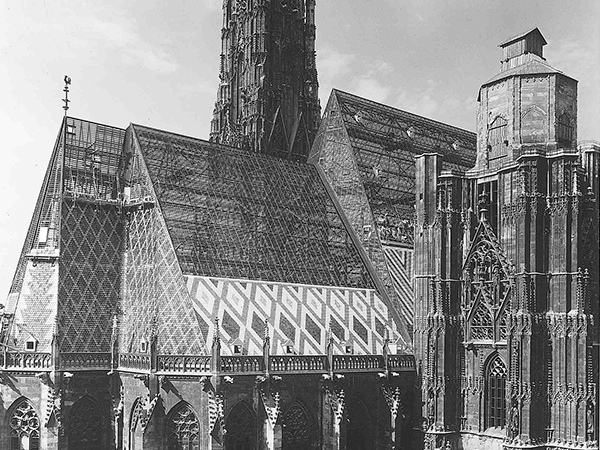
The new roof
Following the destruction of the medieval larch wood roof truss, the decision was made to rebuild the roof in a lighter steel construction. The original roof height and pitch were retained in the new roof construction. The roof was covered and finished in 1950.
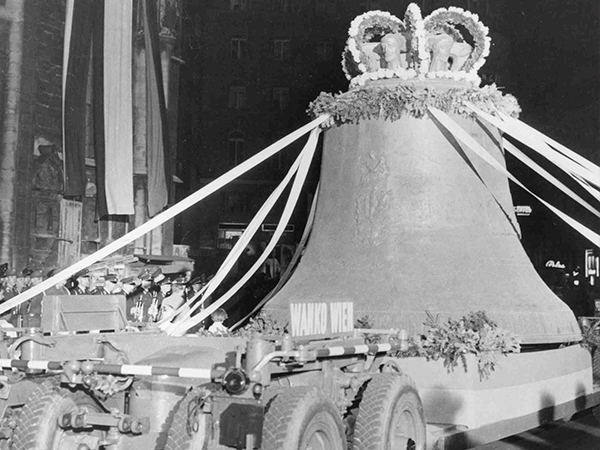
Reopening of St. Stephen
On 26 April, the cathedral church was ready to be reopened by Theodor Cardinal Innitzer after St. Stephen had been rebuilt in just seven years with active financial support from the federal states and numerous fundraising campaigns. As a special event, the new ‘Pummerin’ arrived in Vienna on this day of festivities. The bell had been newly cast in St. Florian near Linz and brought to Vienna in a triumphal procession where it was received at Stephansplatz by a cheering crowd. The consecration of the bell and subsequent consecration of the cathedral by Cardinal Innitzer became an unforgettable celebration.
Giant Organ
During the cathedral fire on 12 April 1945, the cathedral organ in the west gallery was also affected by the roof truss fire and completely destroyed within a very short time. Thus, the cathedral needed a new organ. The contract was awarded to the organ builder Johann Michael Kaufmann after financial support from the Federal Republic of Germany had been received. It was consecrated on 2 October 1960.
Rieger Organ
On the occasion of the 650th anniversary of the Albertine Choir, the construction of a new cathedral organ was started. The contract was awarded to the Rieger company that built the organ in 1991.
Archaeological examinations
In 1996/97, archaeological excavations were carried out in St. Stephen’s Cathedral under the direction of the Federal Office for the Preservation of Historical Monuments (Bundesdenkmalamt) and an examination of the architectural history of the Giant’s Door was carried out. The scientific examination of the cathedral church brought many new insights.
Giant Organ
In autumn of 2017, work was begun to dismantle the giant organ and to transport the organ pipes to the Rieger company for restoration and adaptation. The organ is to be rebuilt in 2019 and consecrated by His Eminence Christoph Cardinal Schönborn at Easter 2020.
Please continue your support and help us preserve St. Stephen’s Cathedral for future generations. Thank you for your contribution.
Donations